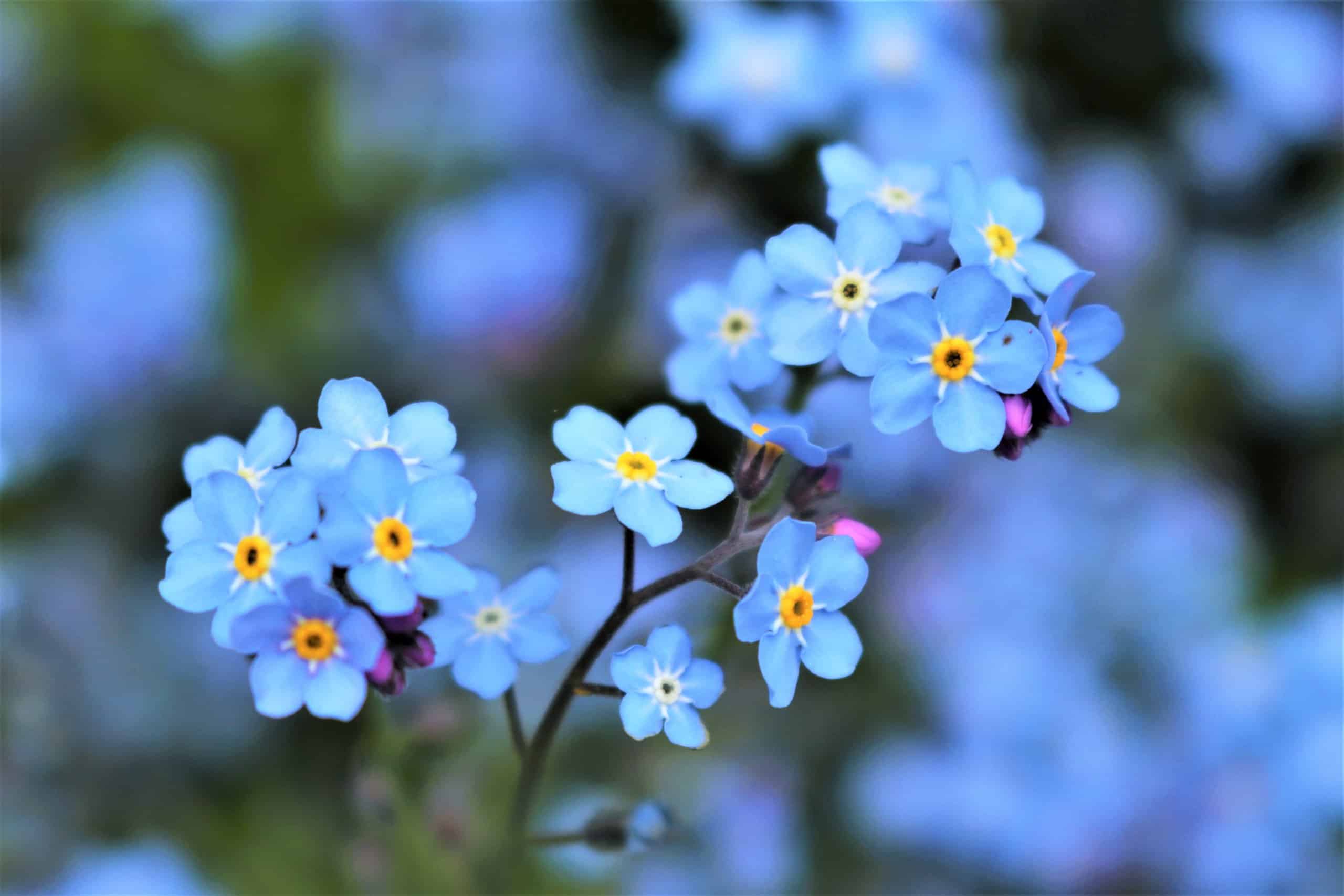Alaska is home to a vast array of native plant species, ranging from wildflowers and grasses to shrubs and trees. These plants are adapted to the state’s cold, harsh conditions and create an important foundation for biodiversity in the region. They provide habitat and food sources for many animal species while also contributing to soil health and forest regeneration. From alpine meadows carpeted with colorful blooms to thick forests filled with towering evergreens, exploring Alaska’s native plants is a unique opportunity for all nature lovers. Let’s take a closer look at 12 native plants in Alaska!
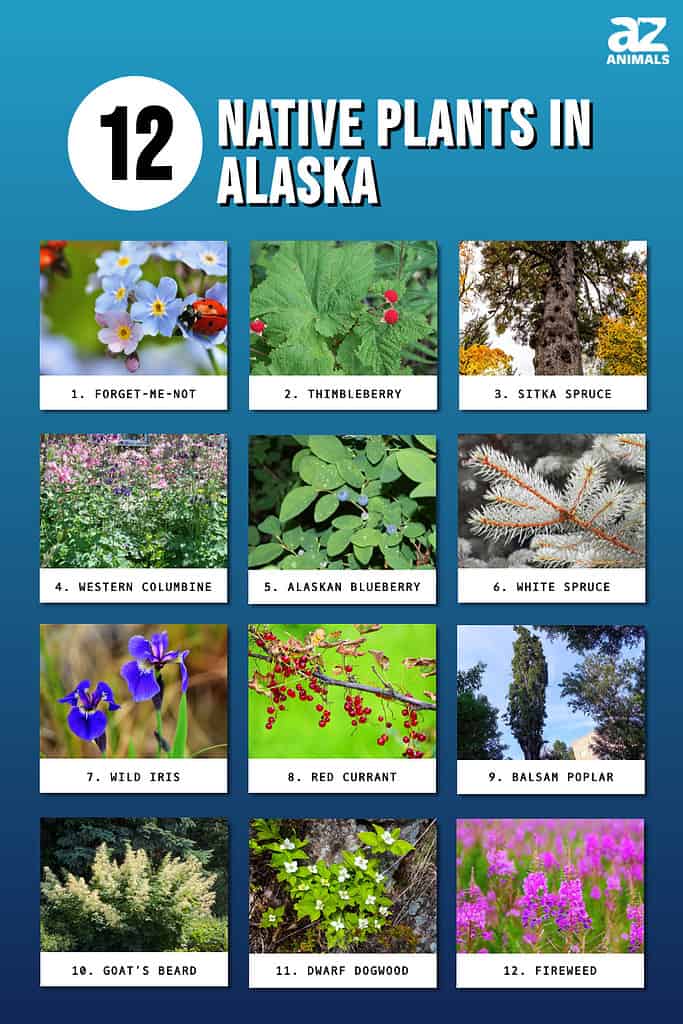
1. Forget-Me-Not (Myosotis alpestris)
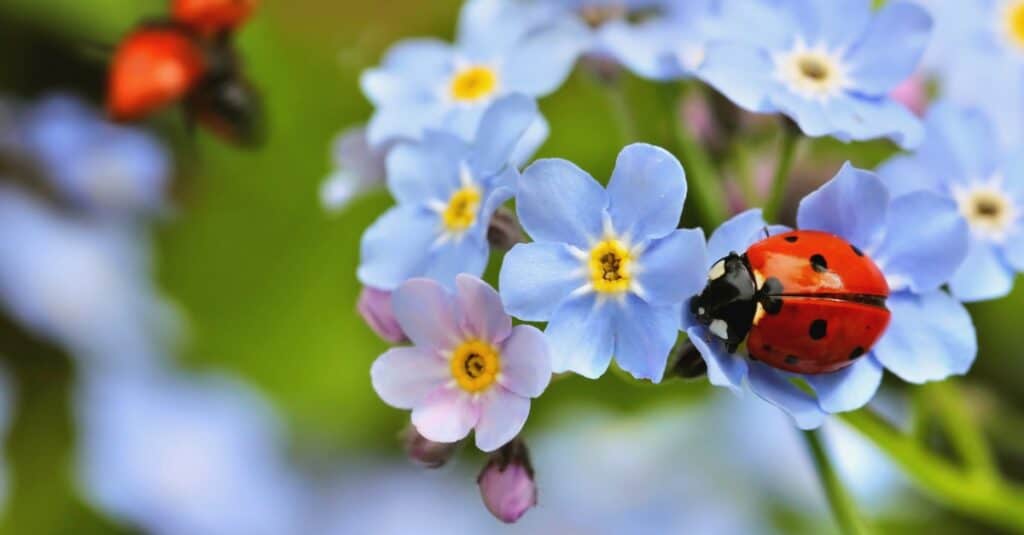
Forget-me-not is the state flower for Alaska.
©Marek Mierzejewski/Shutterstock.com
Alaska’s state flower is the beautiful and fragrant forget-me-not wildflower. Growing 5 to 12 inches tall, these delicate blossoms live in mountain meadows throughout the state. They grow close to the ground with tall, fragile stems that reach up to eight inches in height, topped with five-petal blooms in shades of pale blue and pink.
Although small, forget-me-nots make a big impact on the landscape of Alaska, often found tucked amongst the lush green grasses and mossy patches that cover much of the state. The best time to see these charming and sweet-scented little flowers is from late June to late July.
2. Thimbleberry (Rubus parviflorus)
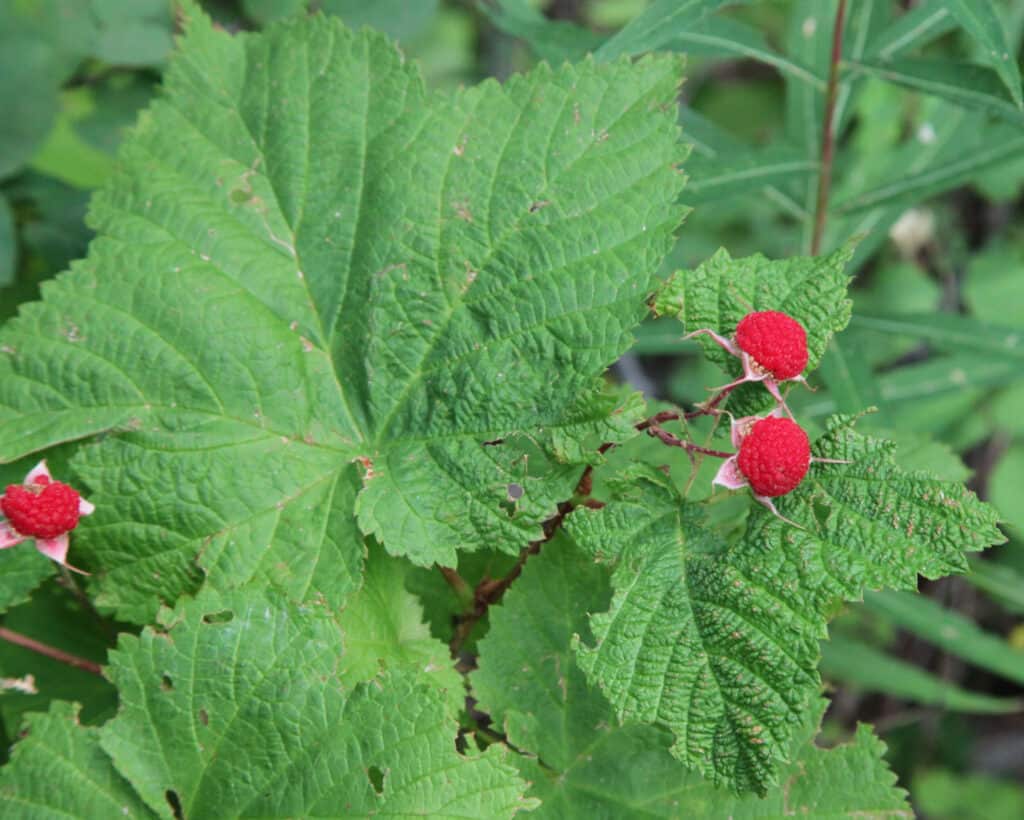
A ripe thimbleberry will be extremely fragile and soft.
©Nikki Yancey/Shutterstock.com
These small, delicately flavored berries grow on deciduous shrubs that reach heights up to 6 feet tall, creating a bright, colorful landscape wherever they appear. Thimbleberries can be found in many parts of Alaska during the summer months, typically along the edges of shorelines and forests. They have maple-shaped leaves and small white flowers that cluster loosely together. The five delicate petals of each thimbleberry flower resemble crinkled tissue paper. The flowers eventually produce small red fruits that look like raspberries.
The best time to harvest these treats is mid-July to late August. This is usually when the thimbleberry bushes will be full of ripe and juicy berries. Whether used for jams or enjoyed freshly picked, thimbleberries provide a wonderful addition to any summer day in Alaska.
3. Sitka Spruce (Picea sitchensis)

The Sitka spruce is an evergreen tree native to the coastal areas of Alaska.
©iStock.com/Brittany Olson
Alaska’s official state tree is the Sitka spruce. The Sitka spruce is an evergreen tree native to the coastal areas of Alaska. It can grow over 300 feet tall and produces dark, glossy-green needles that stand out amongst the forests in which it grows. Sitka spruce often grows along riverbanks, wetland margins, estuaries, and beaches in Southeast, Southcentral, and Southwest Alaska. It is a fast-growing tree that can grow in areas with clay, loam, or sandy soils, and is one of the largest tree species in Alaska.
Because it is such a hardy species, the Sitka spruce is able to withstand harsh winters and strong storms, making it an important part of the Alaskan landscape. Although many of the older trees have been cut down and harvested over the years, there are still a few Sitka spruce trees in Alaska that are over 700 years old! These majestic trees also provide homes and food for several types of animals, from birds to reptiles, amphibians, and mammals.
4. Western Columbine (Aquilegia formosa)
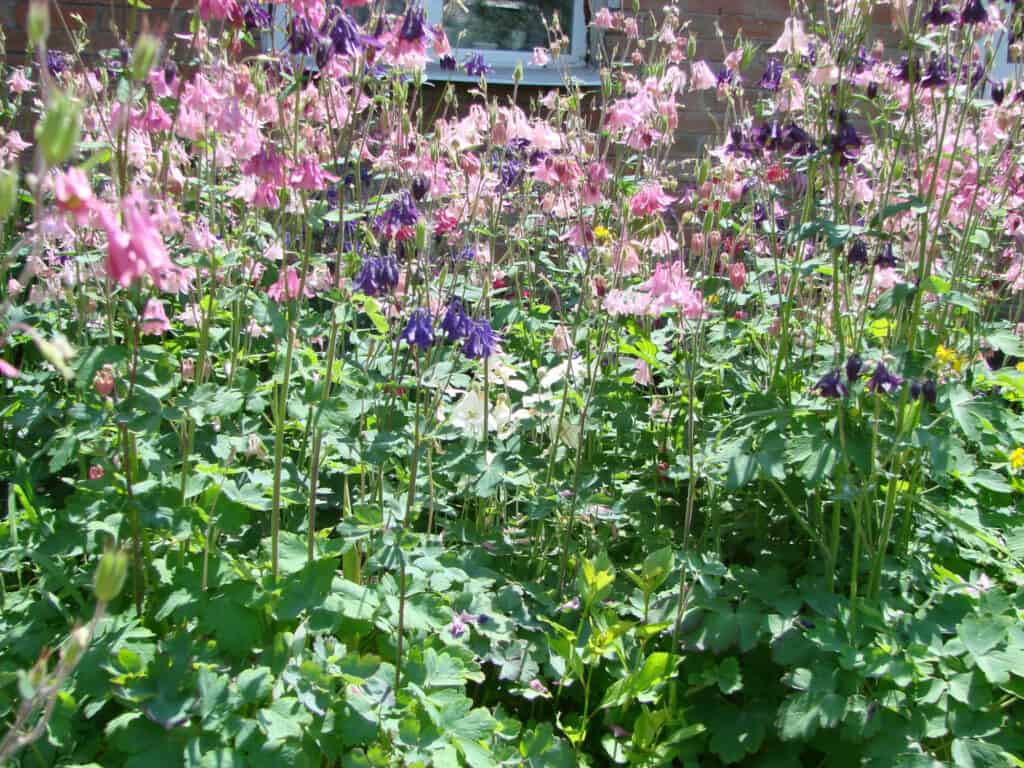
Western columbine plants have a bell-shaped blooming structure with vibrant shades of yellow and red.
©Michiru13/Shutterstock.com
These vibrant flowers can be found growing across many parts of Alaska. They typically thrive in moist areas of woodlands, forests, and alpine or subalpine meadows. Western columbine plants have a bell-shaped blooming structure with vibrant shades of yellow and red. These colorful drooping flowers are around 2 inches long, while the plant itself can grow up to 30 inches tall.
Pollinators that have long tongues — like hummingbirds and butterflies — are frequent visitors to western columbine flowers. The nectar they seek is located in the tips of the petals, and only those with long tongues can access it. The name of the flower originates from its resemblance to a group of doves huddled around a bowl. Its Latin name is “columba”, which translates to “dove”.
5. Alaskan Blueberry (Vaccinium alaskanum)
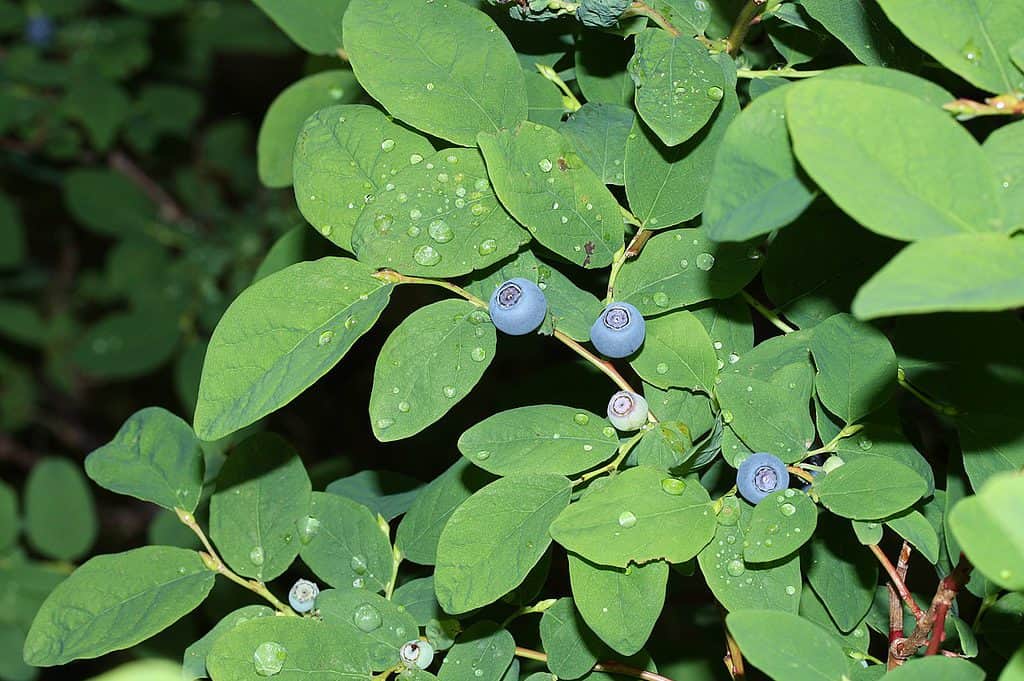
When ripe, Alaskan blueberries are sweet and juicy.
Found along coastal forests of Alaska, the Alaskan blueberry can grow up to 6 feet tall. This deciduous shrub has dark green leaves with a whitish-colored underside, and pink to pink-bronze bell-shaped flowers. Alaskan blueberry plants have edible blueberries that are a deep, rich blue, purplish-black, or bluish-black color. They are typically about the size of a pea or smaller.
When ripe, Alaskan blueberries are sweet and juicy and offer an explosion of flavor with every bite. They make for an excellent addition to pies, muffins, and jams. They are also delicious on their own as a healthy snack. Not only are they tasty, but wild Alaskan blueberries are also an essential part of the diets of many animals, from small birds to even large bears!
6. White Spruce (Picea glauca)
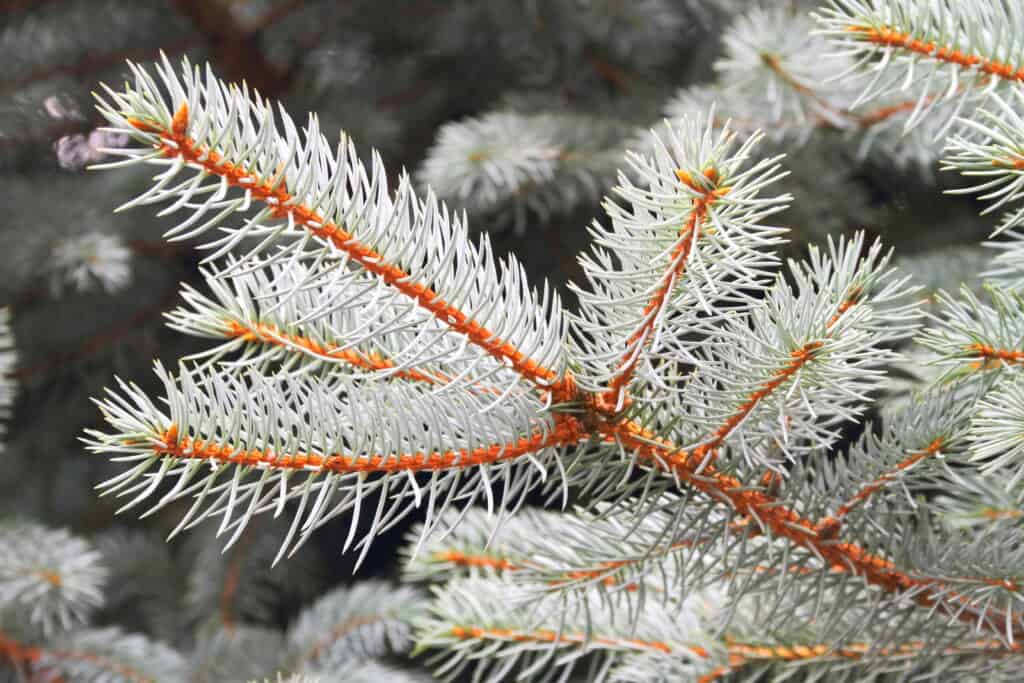
The white spruce tree typically grows between 50 and 100 feet tall.
©Taiftin/Shutterstock.com
White spruce is a species of evergreen coniferous tree native to Alaska that grows mostly in taiga biomes (forests in cold and subarctic areas) in the northern regions of the world. This tree frequently grows in both boreal and coastal regions, especially in areas with cool temperatures. White spruce trees typically grow between 50 and 100 feet tall and have a medium-sized crown, shallow roots, and thin cylindrical needles that allow the needles to stay on the branches for several years.
The wood of this tree is strong, lightweight, and resistant to rot, making it a popular material among Alaskan builders for things like furniture and flooring. White spruce provides wildlife with protective cover from the elements and is an important part of Alaskan ecosystems.’
7. Wild Iris (Iris setosa)

Wild irises are popular staples for Alaskan gardens.
©JT Fisherman/Shutterstock.com
These stately, purple-hued blooms can be found in meadows, bogs, and along the edges of streams and lakes. Wild irises can range anywhere from 6 inches to 2 feet tall, with sword-like, thin leaves that add texture and drama to the plant. The blossoms have three sepals that help attract pollinators. However, these sepals look much more like large petals with rich blue and purple hues (the actual petals of a wild iris are at the center of the flower and are quite small).
Wild irises are a popular staple for Alaskan gardens due to their hardiness and ability to grow even in colder climates. Although beautiful, both the roots and the seeds from this plant are poisonous.
8. Red Currant (Ribes triste)

Red currant berries are juicy with a distinctive reddish-pink color.
©Amelia Martin/Shutterstock.com
This deciduous shrub grows around 2 to 3 feet tall in moist meadows, woodlands, and along the banks of streams and rivers. It has maple-shaped leaves with small red flowers hanging below.
Growing on these low-lying shrubs, red currant berries are juicy with a distinctive reddish-pink color and a tart flavor that makes them great for jams and jellies. They usually grow in clusters of three to 10, and each individual berry is usually the size of a corn kernel. With their bright flavor and colorful appearance, red currant berries are popular additions to pies, cobblers, pastries, and salads.
9. Balsam Poplar (Populus balsamifera)
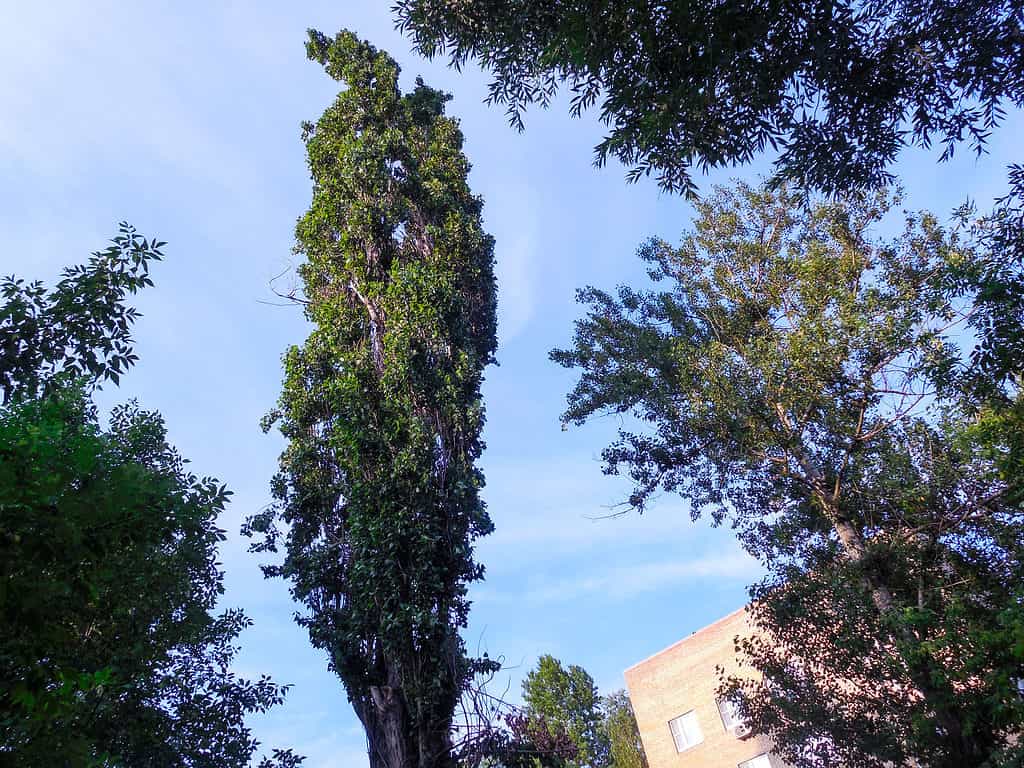
Balsam poplars are named for their delightful fragrance.
©Marina Bakusheva/Shutterstock.com
In Alaska, you will find a variety of balsam poplar trees, with many distinct subspecies existing in the state. Balsam poplars in Alaska are known for their impressive size, with some potentially reaching up to 150 feet tall. Their leaves are rounded at the base and have pointy tips with a waxy coating on their underside.
Balsam poplars are named for the delightful fragrance their new leaves and buds exude during the springtime. They are scattered throughout sub-boreal and boreal regions of Alaska and are very productive in interior Alaska. Balsam poplars generally grow along rivers and in floodplain forests.
10. Goat’s Beard (Aruncus sylvester)

Goat’s beard typically grows in moist or coastal areas.
©Brzostowska/Shutterstock.com
With feathery foliage and small white flowers, goat’s beard is a native plant in Alaska that grows 3 to 5 feet tall. Goat’s beard typically grows in moist or coastal areas, meadows, open woods, forests, and near water sources.
These plants have reddish stems, and the leaves are divided into multiple smaller leaflets with toothed edges and serrated margins. Tiny cream-colored flowers grow atop long branching flower spikes that stretch above the foliage. The plant’s genus “aruncus” is derived from the Greek word “aryngos“, which means “goat’s beard” and describes these characteristic, large, fluffy white flower clusters.
11. Dwarf Dogwood (Cornus canadensis)

The dwarf dogwood is a shrubby, deciduous groundcover that typically grows 4 to 8 inches tall.
©iStock.com/cpjanes
Dwarf dogwoods are native plants in Alaska’s wilderness and typically grow in tundra, woodlands, and low alpine habitats. Commonly called dwarf cornel or bunchberry, dwarf dogwood is a shrubby, deciduous groundcover that typically grows 4 to 8 inches tall and spreads through creeping rhizomes. Dwarf dogwood plants have dark green, oval leaves that turn a deep crimson or purple color in the fall. The beautiful “flowers” at the center of the plant are actually a group of modified leaves or bracts. These white leaves mimic delicate flower petals and attract pollinators to the plant’s tiny flowers in the center.
Bright red, edible berries eventually replace these white blossoms. Dwarf dogwood berries are tart, with a slightly sweet flavor. They have a slightly dry taste or a mild apple flavor. Many people make them into jams or eat them fresh. Dwarf dogwood thrives in moist climates and often grows near bogs, streams, and wetlands, as well as on rocky hillsides and mountain slopes. This hardy shrub provides nectar for pollinators and is a food source for birds, mammals, and other wildlife.
12. Fireweed (Epilobium angustifolium)
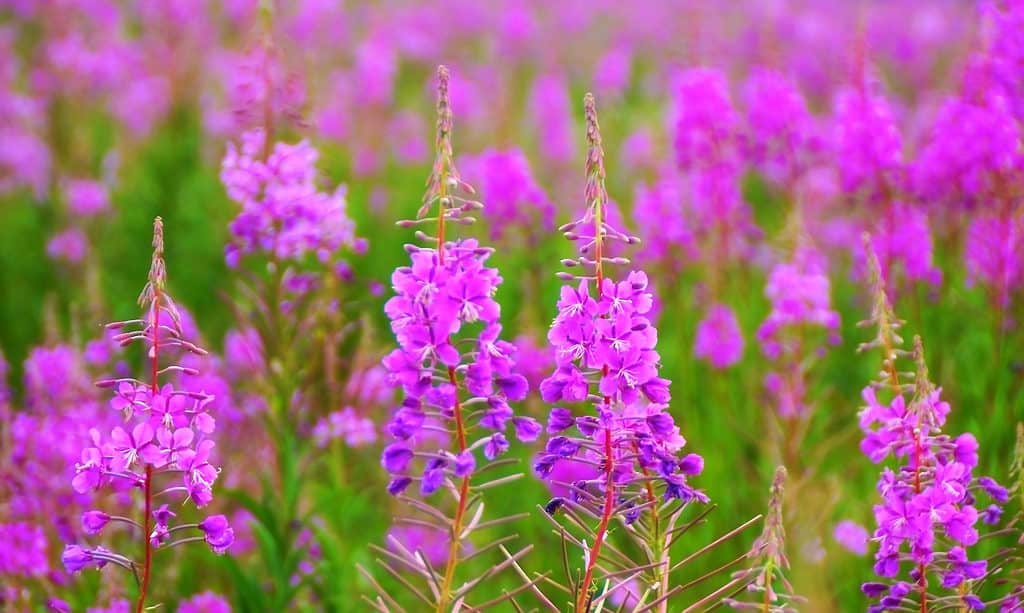
When autumn hits, fireweed leaves change from green to purple, red, and orange.
©Real Moment/Shutterstock.com
One of the most well-known native wildflowers in Alaska is fireweed. This beautiful flower lives in habitats from meadows and pastures to coastal regions and disturbed soils. It grows quickly and can reach 2.5 to 5 feet tall with sprawling stems covered in narrow leaves. Its pink-purple flowers bloom in drooping clusters from mid-summer until late autumn, providing a vivid splash of color during the summer months. When autumn hits, fireweed leaves change from green to purple, red, and orange.
With deep roots, fireweed can escape fire, and its seeds are able to stay viable in the soil for many years. When sunlight returns after a fire burn over the area, fireweed appears once again en masse, providing quick-growing vegetation on an otherwise empty landscape. There is also a smaller type of fireweed native plant in Alaska, called dwarf fireweed (Epilobium latifolium) or river beauty. This pint-sized fireweed wildflower species can be found in areas with gravelly soil, such as along streams and river banks or on scree slopes in mountains. It rarely grows taller than 20 inches.
Summary of 12 Native Plants in Alaska
| Number | Native Plant |
|---|---|
| 1 | Forget-Me-Not |
| 2 | Thimbleberry |
| 3 | Sitka Spruce |
| 4 | Western Columbine |
| 5 | Alaskan Blueberry |
| 6 | White Spruce |
| 7 | Wild Iris |
| 8 | Red Currant |
| 9 | Balsam Poplar |
| 10 | Goat’s Beard |
| 11 | Dwarf Dogwood |
| 12 | Fireweed |
Thank you for reading! Have some feedback for us? Contact the AZ Animals editorial team.

